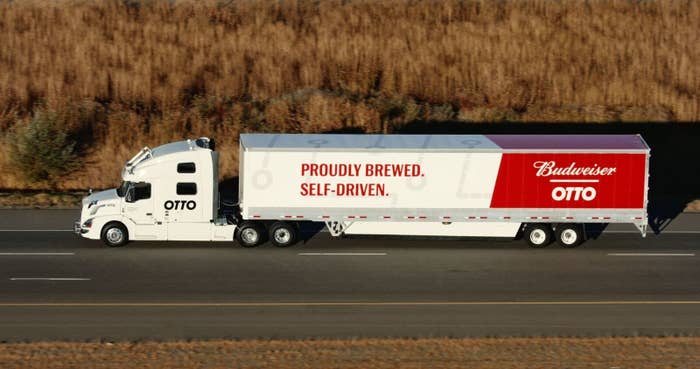
A self-driving truck from Otto, the startup Uber acquired this summer, drove a trailer of 2,000 cases of Budweiser more than 120 miles across Colorado on Thursday morning with the driver in the back seat, Otto announced today. And with this foray into cargo transportation, the ride-hail giant is launching Uber Freight, a platform to connect shippers and truck drivers.
The beer shipment for Anheuser-Busch is the first (publicly known) self-driving truck delivery, Otto says. It comes about two months after Uber acquired Otto, which was co-founded by Anthony Levandowski, an engineer who helped build Google’s first self-driving car and who is leading Uber’s pilot program to put passengers in self-driving cars in Pittsburgh.
“We can really bring Uber-like efficiency to the logistical market, and the same sort of experience you have of pressing a button and having an Uber driver show up after three minutes,” said Lior Ron, another Otto co-founder and also a veteran of Google, where he helped scale Google Maps. “The major building blocks are here ... We have now the basic technology in place to do more of those shipments.”

A commercial truck driver drove the vehicle from Anheuser Busch’s distribution center in Loveland, Colorado, to the highway, and then crawled into the back seat, where he spent the next two hours watching the truck drive itself to Colorado Springs.

Anheuser-Busch approached Otto about a partnership after the self-driving truck company launched in May, said James Sembrot, senior director for logistics strategy at the beer conglomerate.
Sembrot told BuzzFeed News that Anheuser-Busch estimates it can save 20–35% of the diesel its shipments use with self-driving trucks, which are more fuel-efficient. That could mean $40–50 million in annual fuel savings for his company, he said, if it were to one day complete all its shipments with trucks outfitted with Otto’s self-driving technology.
“I know, as one of the largest shippers in the United States — we ship over 1 million truckloads of our beers each year, driving 450 million miles every single year — that we have lots of opportunity to use this technology,” Sembrot said. “We’re excited to move this forward, but we can only move at the pace of availability.”
Anheuser-Busch paid Otto $470 for the delivery, a rate Sembrot called a market average. Ron said Otto is “actively discussing” partnership possibilities with other companies and truck manufacturers.
Increasingly, Uber is leveraging its platform to provide logistics services, such as food delivery through Uber Eats. Last year, it launched UberCARGO in Hong Kong – a service people can use to move their furniture, for example, or that businesses can hire to make deliveries. “If we can get you a car in five minutes, we can get you anything in five minutes,” Uber CEO Travis Kalanick told Vanity Fair in 2014. Uber Freight is the next step in that plan. Ron told BuzzFeed that Otto plans to “really accelerate and get to deployment as soon as possible.”
Otto isn’t the only company developing self-driving truck technology. The truck company Freightliner unveiled a prototype self-driving truck last year. Daimler, the parent company of Mercedes-Benz, has also been testing automated truck platoons. And Peloton, a startup based in Mountain View, California, is working on automating trucking as well.
Trucking is a huge market in the US and could eventually serve as a revenue-booster for Uber, which lost $2 billion in 2015 and $100 million in the US in the second quarter of this year, according to Bloomberg. Revenue for trucking companies reached a record $726 billion in 2015, according to the American Trucking Associations (ATA).
There are more than 3 million truck drivers in the US, according to the ATA, leading to concerns that if and when truck platoons are automated, millions of people could be out of jobs. Headlines have pondered “What's the future for America's 3.5 million truckers?” and “Will Technology Make Truck Drivers Obsolete In 10 Years?” In many states, trucking is the most common job. But Ron said he expects it’ll be years before technology would no longer necessitate human drivers.
“For the foreseeable future, there’s still a driver in the cabin,” Ron said. “He’s just now a co-pilot with the technology, with the computer, driving in the complex environment, [like] the city streets.”’
